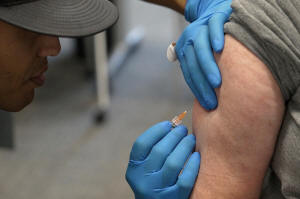Texas measles outbreak expected to last for months, though vaccinations
are up from last year
[March 22, 2025]
By DEVI SHASTRI and KASTURI PANANJADY
As measles cases in West Texas are still on the rise two months after
the outbreak began, local public health officials say they expect the
virus to keep spreading for at least several more months and that the
official case number is likely an undercount.
But there's a silver lining, officials say: More people have received a
measles, mumps and rubella vaccination this year in Texas and New
Mexico, which also has an outbreak, compared to last year — even if it's
not as high as they would like. And pharmacies across the U.S.,
especially in Texas, are seeing more demand for MMR shots.
As of Friday, the outbreak in Texas was up to 309 cases and one
measles-related death, while New Mexico's case count was up to 42 and
also one measles-related death. Forty-two people have been hospitalized
across the two states.
Texas' outbreak, which has largely spread in undervaccinated Mennonite
communities, could last a year based on studies of how measles
previously spread in Amish communities in the U.S. Those studies showed
outbreaks lasted six to seven months, said Katherine Wells, director of
the public health department in Lubbock, Texas. Lubbock's hospitals have
treated most of the outbreak's patients and the public health department
is closely assisting with the response.
“It being so rural, now multistate, it's just going to take a lot more
boots on the ground, a lot more work, to get things under control,”
Wells said during a media briefing this week. “It's not an isolated
population."

The outbreak includes 14 Texas counties, two New Mexico counties and
four probable cases in Oklahoma, where health officials said the first
two were “associated” with the West Texas and New Mexico outbreaks.
Measles is one of the world's most contagious diseases. The way it
spreads makes it especially hard to contain and outbreaks can have
multiple peaks, said Justin Lessler, an epidemiologist at the University
of North Carolina’s Gillings School of Global Public Health.
Many people spread the measles virus unknowingly for days before the
telltale rash appears. The virus also can hang in the air for up to two
hours after a sick person has left a room.
“Within this community, it’d be perfectly reasonable to think probably
another couple months before things die out,” Lessler said. “But if it
gets into another community, you just potentially start that clock over
again.”
If the outbreak goes on until next January, it would end the United
States' status of having eliminated measles, which is defined as 12
months without local virus transmission, said Dr. William Moss, a
pediatric infectious disease specialist at Johns Hopkins University and
executive director of the International Vaccine Access Center.
“We’re only three months in. I think if we had a strong response where
the messaging was clear that measles vaccination is the way to stop this
outbreak, I would be surprised if it went for 12 months or more,” said
Moss, who has worked on measles for 25 years, mostly in Africa. “But
we’re not seeing that type of response, at least from the federal
government.”

[to top of second column]
|

Matt Caldwell, left, a Lubbock Fire Department official, administers
a measles, mumps and rubella vaccine to Clair May, 61, at the
Lubbock Health Department, Feb. 26, 2025, in Lubbock, Texas. (AP
Photo/Mary Conlon, File)
 U.S. Health and Human Services
Secretary Robert F. Kennedy Jr. instead has sown doubt about the
measles vaccine, which has been safely used for more than 60 years
and is 97% effective after two doses. In an interview with Fox News
last week, Kennedy said MMR shots cause “deaths every year,”
although he later added that vaccinations should be encouraged.
Vaccinations are up in Texas and New Mexico
Still, there are signs the outbreak has had an effect on
vaccinations, especially locally.
Between Feb. 1 and March 18 last year, New Mexico Department of
Health registered 6,500 measles vaccines. During that timeframe this
year, more than 11,600 measles vaccines were administered in New
Mexico — about half given to adults and half to children.
Southeast New Mexico, where the outbreak is located, represents a
large portion of the count, with 2,369 doses administered.
In Texas, at least 173,000 measles doses were given from Jan. 1 to
March 16, compared to at least 158,000 over the same timeframe last
year, according to the state health department. That includes more
than 340 doses in given by public health in the West Texas outbreak
area as of March 11.
Texans must opt-in to the state’s immunization registry, so most
people’s vaccinations are not captured in the Texas Department of
State Health Services numbers, department spokeswoman Lara Anton
said.
“We don’t know if more people are opting in or if this is a true
reflection of an increase in vaccinations," Anton wrote in an email.
"It may be both.”
Pharmacy chains Walgreens and CVS told The Associated Press that
they're seeing higher demand for MMR vaccines across the U.S.,
especially in the outbreak areas.

Texas health officials say they’d like to see more uptake in the
communities at the epicenter of the outbreak, especially in Gaines
County — where the childhood vaccination rate against measles is
82%. That's far below the 95% level needed to prevent community
spread, and likely lower in the small religious schools and
homeschooling groups where the early cases were identified.
Prasad Ganji is a pharmacist in Seminole, the biggest town in Gaines
County. He said he ordered a 10-dose box of the MMR vaccine as cases
started to spread.
He can give vaccines to people older than 14. But he still has doses
left.
“The uptake for vaccines been definitely been a struggle," Wells
said of Gaines County, "I want to be honest with that.”
All contents © copyright 2025 Associated Press. All rights reserved |